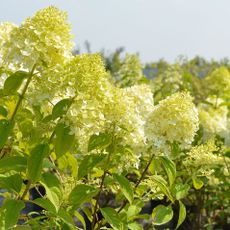Tapeworm Plant Care - How To Grow A Tapeworm Plant

Among the virtual unending oddities of the plant world, we find one with the rather nauseating name of “tapeworm plant.” What is a tapeworm plant and is growing tapeworm plants a possibility in your area? Let's learn more.
What is a Tapeworm Plant?
The tapeworm plant (Homalocladium platycladum) is also referred to as the ribbon bush, although the latter name is more appropriate as you will find out. Native to the Solomon Islands, this plant is a member of the Polygonaceae or knotweed family amongst which rhubarb and buckwheat count as relations. It is categorized as a shrub, but a shrub like no other. This plant is more or less leafless. Its growth is that of flat, segmented green stems about half an inch (1 cm.) wide and resembling, you guessed it, tapeworms. These odd stems radiate upward from the base to a height of between 4 to 8 feet (1-2 m.) or even taller if supported with a spread of between 6 to 8 feet (2 m.) across. The older stems become slightly more rounded, while young stems bear fleeting 1 to 2 inch (2.5-5 cm.) leaves. In late fall through winter, small greenish white flowers are borne at the stem joints followed by tiny red fruit. The fruit is edible but not particularly pleasant tasting. A true curiosity amid the plant kingdom, it makes one want to know how to grow a tapeworm plant.
How to Grow a Tapeworm Plant
Tapeworm plant may be planted in full sun to shade but it tends to really flourish with some protection from the hot sun. Surprisingly, it is drought tolerant, but for optimal tapeworm plant care, it should be kept moist. In warm climates it can be cultivated outdoors, but in cooler regions the plant should be potted so it can be moved indoors when temperatures cool. Tapeworm plant is a hardy evergreen down to around 25 degrees F. (-4 C). Cold temperatures for any length of time may kill off the stems, but the plant will re-sprout at its base. A truly unique specimen plant, tapeworm plant care is relatively low maintenance. Both cold and drought tolerant, and as it is a fairly rapidly growing plant, tapeworm can even be pruned back to reign in its height. There is no secret or difficulty when growing tapeworm plants. Propagation can be attained either via seed or cuttings. The seeds should be sown in good quality potting medium, a mix of 2 parts potting soil to 1 part perlite or coarse sand is ideal. Keep the seeds moist, temps at 70 degrees F. (21 C.) and at a humidity of over 40 percent. In 14 to 21 days, you will have one of these unique, sure to be the talk of the neighborhood specimens of your own.
Gardening tips, videos, info and more delivered right to your inbox!
Sign up for the Gardening Know How newsletter today and receive a free download of our DIY eBook "Bring Your Garden Indoors: 13 DIY Projects For Fall And Winter".

Amy Grant has been gardening for 30 years and writing for 15. A professional chef and caterer, Amy's area of expertise is culinary gardening.
-
 Grow Limelight Hydrangea Shrubs For Green Themed Displays And Brilliant Borders
Grow Limelight Hydrangea Shrubs For Green Themed Displays And Brilliant BordersIf you're a panicle hydrangea lover in search of flamboyant, long-lasting florals, knowing how to grow Limelight hydrangea shrubs will ensure gorgeous green blooms
By Mary Ellen Ellis
-
 How To Reuse Plastic In Your Garden: 9 Clever Ways To Keep Waste Out Of The Landfill
How To Reuse Plastic In Your Garden: 9 Clever Ways To Keep Waste Out Of The LandfillRepurposing is a great way to reuse plastic in the garden. We have gathered some clever ideas about ways to reuse plastic that are helpful for gardeners.
By Teo Spengler